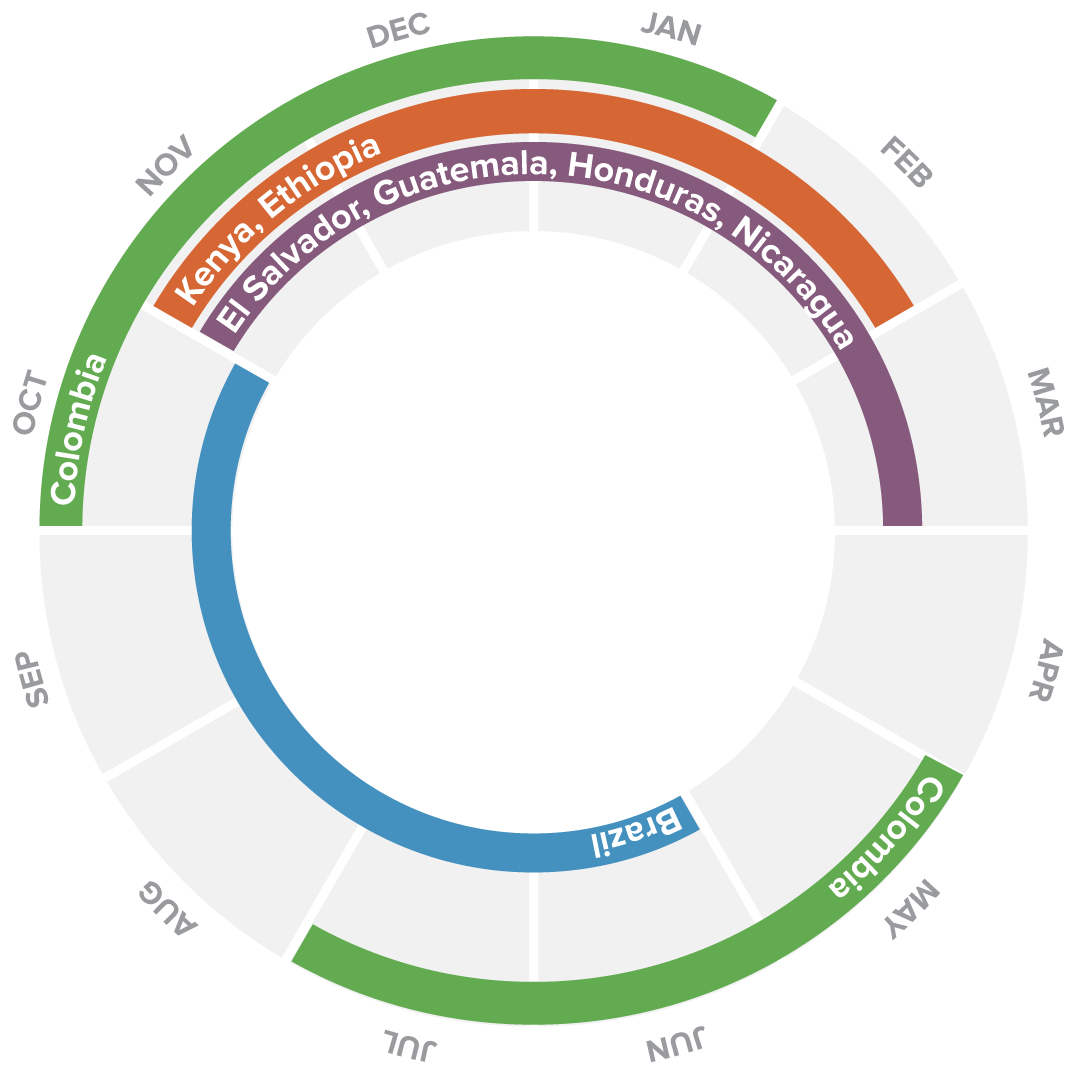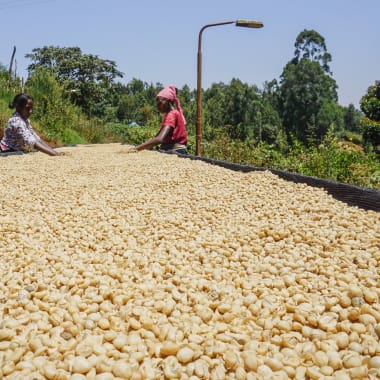-
Producer
-
Gatuya Coffee Factory
-
Country
- Kenya
-
Region
-
Murang'a
-
Altitude
-
1750m above sea level
-
Varieties
-
Process
-
Importer
-
Silo
-
Body
-
Full
-
Acidity
-
Bright
-
Tasting notes
-
Crisp pink grapefruit, orange
-
Roast style
Kenya
Gatuya Aa
Gatuya Coffee Factory is located in a valley between two hills, near Kahuro town, in the Muranga District of the Central Province.
It was established in 1962 and is currently affiliated with the New Murarandia Farmers Coop Society.
The region is unusual in having a biennial production cycle: the main harvest takes place from October to December, and a smaller harvest from March to May. In most of the world (aside from Colombia’s diverse microclimates) a single annual harvest is typical.
Farmers in this region deliver their cherry to the factory (also known as a wetmill) where it is depulped, dry-fermented, washed and soaked using water pumped from the River Muriuriu to the reservoir tanks.
Parchment is then dried on raised tables (shown in the picture on this page) during which time it is frequently turned and constantly sorted by hand to remove any defects.
From farmer to coop to factory
Kenya’s coffee production is made up of smallholder coffee farms, large estates and small estates. There are over 700,000 smallholders who make up about 55% of the Kenya’s production.
Smallholders are organized in to cooperative societies, which act as umbrella organisations for the factories (also known as wetmills) where these producers deliver their coffee crops for processing.
There can be several factories in an area which farmers are free to choose to deliver their cherry. Due to the traditional auction system in Kenya, quality is rewarded with higher prices. Better factories attract more farmers by producing coffee that fetches the highest prices, in turn giving higher returns to the farmers.
The Gatuya factory where this coffee was processed is managed by Ephantus Gathungu and has eleven permanent staff working throughout the year, joined by extra casual staff during peak months.
The factory has recently invested in depulping equipment and is dedicated to environmental conservation, utilizing three waste water soak pits.
A coffee calendar

Like all farmed crops, coffee plants are affected by seasons and most countries have specific harvest periods where workers will travel through coffee regions picking coffee by hand. This seasonality means you'll see different countries come and go from cafes through the year, and it's also the reason coffee blends change through the year as fresh crops arrive.
At the moment we’re drinking lots of Colombian coffees because the Central and South American harvests are the latest harvests to reach Australia, with the new season Ethiopian and Kenyan coffee crops expected to hit our shores in June or July.
With this delivery we’re taking a break from the fresh Colombians and revisiting one of last year’s Kenyans that we’ve been drinking in the cafe that didn’t make it out to Brew Crew last year.
We hope you enjoy the Gatuya, and are joining with us in eagerly awaiting the arrival of the African harvests in the coming months.
Learn everything about this coffee:
Ethical, traceable sourcing
This page has all the sourcing information (variety, process, region, story, importer, and more) that our importers share with us, and give us permission to use.
The transparency helps us talk confidently about the quality and background of our product, and it helps you know exactly what you’re buying.
Learn more:
Coffee page transparency legend
Our coffee philosophy
Our business approach
Fresh harvest coffee
We only source and roast coffee from each country’s latest harvest season (so the green coffee is never older than 1 year from the time of picking, processing and packing). This ensures the sensory qualities are always at their peak and unaffected by excessive ageing.
Roasted for espresso and filter (best enjoyed black)
Roast style: omni. Omni roasts are designed to brew and taste great both as espresso and filter. Our omni single origins generally sit on Agtron values in the ~70-60 value range. So, technically, they are somewhere in the lighter side of the medium spectrum.
Designed for espresso and filter brewing. Best enjoyed black.
Learn more:
Our Loring Kestrel S35 roaster
Our roasting style and approach
Best brewed within days 15-49 post-roast
The ‘fresh is best’ saying doesn’t apply to coffee (contrary to popular belief). Waiting before opening and brewing your bag of whole coffee beans helps develop peak flavour and acidity.
But heads up: if you buy pre-ground coffee, brew it as soon as possible.
Learn more:
Our recommended brewing window
Try our custom brewing recipes
Our recipes and ratios are tailored to our coffee sourcing and roasting styles, bringing the best flavour and feel out of each coffee.
For pour over, immersion, and other filter brewing styles, check our brew guides.
For our espresso single origins, we recommend a coffee:yield ratio of 1:3:
- Dose: 20g ground coffee
- Yield: 60g espresso
- Total brew time: ~24-28 seconds
This is just a starting point! We encourage you to experiment, taste, and adjust to find the recipe that you enjoy the most.
Learn more:
Our espresso brew guide (single origin)
Brewing ratio calculator
Packaging and sustainability
- Bags: ABA-certified home compostable (AS 5810-2010)
- Labels: recyclable
- Valves (only on +250g bags): general waste
- Box and tape (online orders): recyclable
Learn more:
Our packaging
Varieties
Ruiru 11 variety
Released in 1985, Ruiru 11 is a disease resistant varietal developed in Kenya
SL28 variety
SL28 was developed in 1931 by Scott Laboratories to suit the growing conditions in Kenya. The varietal is known for its exceptional cup quality
The location
Coffee from Kenya
Alongside Ethiopia and Colombia, Kenya is one of the origins we get most excited about at the roastery. It exports some of the most vibrant, bright, and unique coffees in the world.
The Murang’a region of Kenya
East of Nyeri, also with rich volcanic soils and a high percentage of smallholder producers
Farm processes
Washed process
Machines are used to remove the flesh from the coffee cherry before being fermented in water, washed again, and finally sun dried. This process tends to result in more distinct, cleaner flavours.
2 brew notes from subscribers
Kenya Gatuya Aa
Simon’s Chemex
Sample Coffee Team
👌 crisp Sunday morning brew. Bit of orange flavour coming through as it cools down.
- 42g
- 680ml
Kenya Gatuya Aa
Simon’s V60
Sample Coffee Team
Flavours opened up a lot once it cooled down. Great rainy-day brew.
- 14g
- 240ml
- 3m 5s

Subscribe to a world of coffee
Discover a new single origin coffee from Sample every 1-5 weeks with no delivery fees.
No up-front purchase, and you can pause, cancel, or change plans at any time.
Available to order online this week:

Nicaragua Guillermo Montenegro
Flavours of plum, nectarine, shortbread
Body Acidity
Washed Caturra
March 2025 harvest
Roasted omni for filter and espresso
Nicaragua Guillermo Montenegro online
Kenya Karindundu Aa
Flavours of orange marmalade, grapefruit, Yunnan red tea
Body Acidity
Washed Batian, SL28, SL34, Ruiru 11
Roasted omni for filter and espresso
Kenya Karindundu Aa online
Ethiopia Bekele Gemeda
Flavours of mandarin, white peach, mango
Body Acidity
Washed Ethiopian Heirloom
November 2024 harvest
Roasted omni for filter and espresso
Ethiopia Bekele Gemeda online
Ethiopia Girma Sintayehu Honey
Flavours of apricot, mango, coconut, pineapple
Body Acidity
Honey 75227, Wolisho
February 2025 harvest
Roasted omni for filter and espresso
Ethiopia Girma Sintayehu Honey online